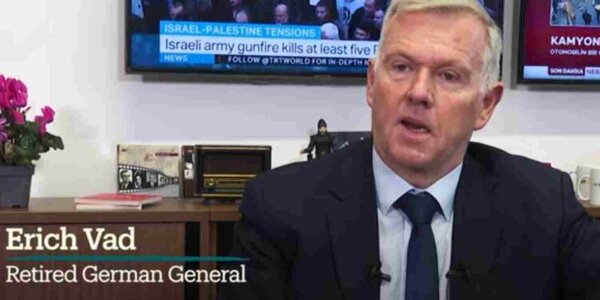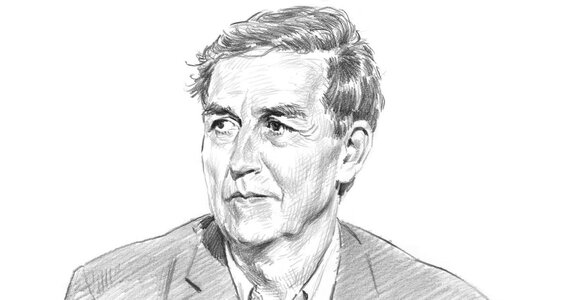Peter Pan goes to Ukraine
Some people never grow up.
The infantilisation of western culture over the last generation or so is an accepted and frequently-discussed reality. But I believe that it has had much more of an impact on western politics than we realise, and that it explains a good part of the Ukraine shambles. Here’s why.
A Saturday or two ago, in the chilly, drizzly weather of an early winter in continental Europe, I went out to do a little shopping nearby, wearing a coat and hat and gloves. In the shops and in the streets I passed other locals, singly, in couples or with children. In all cases, the men were dressed as children. Several were even wearing shorts.
I suppose I was only surprised that I was surprised. The creeping infantilisation of popular culture is now so pervasive that it seems normal. We expect grown-ups to behave little differently from their children, and for popular culture to focus largely on adolescent trivia and things that don’t require seriously making use of the brain. This struck me first looking through the
Guardian news-feed a few days ago, and remembering that the
Grauniad (as it was affectionately known because of its famous misprints) was once a real newspaper with real news, that I bought every day for decades with my own money. These days, I skim through the titles looking for something that might actually be worth reading. It’s essentially a media source for adolescents now, or at least the kind of adolescents we had when I was an adolescent. It features: lots of sport, entertainment, popular music, travel, sex and human-interest stories, punctuated by tantrums from various IdiotPol representatives. You’d have to work hard to actually find out anything useful about the world from it. But that’s only one example: every time I go to YouTube to look at one of the channels I subscribe to, I have to pass the Welcome page with its list of recommended videos, most of which seem to be aimed at people with a mental age of about twelve. And this is the country of Molière and Proust.
OK, I’m not going to go on and on about how things have declined since I was young (though they objectively have) but rather to speculate about how this decline has affected our culture, and particularly our politics. For example; nobody, I think, can fail to have recognised the childish petulance, the childish sulks, and the wishful thinking that have characterised the West’s attitude to the crisis in Ukraine. It’s worth recalling that Putin and Lavrov are old enough to be the fathers of politicians like Macron and Sunak, and there’s a distinct sense of the two Russians as wicked parents telling the children they can’t have what they want: in this case, Ukraine. But where does this come from?
Ultimately, I suggest, we have to go back to 1968: the student revolts of that year were generational struggles disguised as political ones. What the (mostly middle-class) students wanted was more freedom from their parents, both real ones, and symbolic ones like the universities. (The more recent craze for destroying statues and un-personing dead persons is just another manifestation of symbolic revolution against one’s parents.) The “events” of 1968 had many consequences, but two are particularly relevant to this discussion.
One was the exaltation of Youth as a virtue
in itself. Old ideas would give way to new ones, youthful idealism would replace elderly caution and cynicism, the energy of youth would supplant the immobilism of the old. (In other words, the parents/children thing again). This was first applied, interestingly enough, in the business world, and especially in the world of information technology, where it was confidently predicted from the 1980s onwards that “the young” would have an instinctive understanding of computers, and thus go on to dominate the world. A whole series of young nerds, from Gates to Zuckerberg, were going to transform the world, and then transform it again by giving away all the money they had made. Yet all that really distinguished these people was that they came from privileged backgrounds and that they were ruthless, ambitious and very lucky. When actually required to do something that didn’t involve lines of code or simple deviousness, they were basically helpless. I remember seeing photos of Zuckerberg being questioned in some political forum a few years ago: he looked like a frightened adolescent, which in many ways he is. But youth was supposed to “disrupt,” old patterns of business, and those patterns, we later learned, included actually making things that people wanted to buy at prices they were prepared to pay, and making a profit from it. That was so old-fashioned, compared with the exciting world of purely notional electronic goods, as most recently perpetrated by that American idiot whose name I can’t be bothered to look up ( Some Banking-Fraud? Something like that).
But quite quickly, the same logic began to apply to politics. The traditional politician came to the game quite late, with experience of doing something else first. (Even Kennedy had served in World War II, and he was surrounded by experienced people.) These days, youth and ambition are seen as perfectly adequate qualifications in themselves. Today’s politician has seldom done anything else of any value first (and no, merchant banking is not something of value). Politics has become simply a game of climbing the Party ladder, from research assistant to party hack to political adviser to member of parliament to Minister. No qualifications or experience of any kind are required, which is why much of the western world is now run by a generation of political pygmies who don’t understand that there are some problems that social media can’t cope with. When you’ve never done anything else except party politics (and no, merchant banking or consultancy don’t count) you are incapable of managing everyday problems, let alone a real crisis.
The second consequence was the idea of the absolute primacy of individual wants, and the almost magical power of wanting itself. “Be reasonable” said all those Che Guevara tee-shirts, “demand the impossible.”The most important slogan of 1968 was “it is forbidden to forbid.” So the world should fulfil all our wishes and desires. Do what thou wilt shall be the whole of the law. Our parents and society should not be able to dictate our behaviour. That kind of thing. It led variously to the New Age obsession with the idea that “you create your own reality,” to the neoliberal belief that if you are poor and hungry it’s because you haven’t got the right mental approach, and, in conjunction with that other great slogan of 1968, “let’s create new sexual perversions!” to the movement in the 1970s to legalise sexual relations with children (something that seems to be coming back again, as these things tend to do.)
And so it’s not surprising that the western political class has an essentially New Age approach to the war in Ukraine. They
really want to get rid of the current Russian political class and replace it with people like themselves. And as we all know, if you
really want something enough, you will get it. And so the approach is a fantasy one, where such mundanities as terrain, weather, numbers, firepower and so forth are abstracted away. Above all, you
mustn’t say the Russians are winning, or they
might do so. Shhhh! The western PMC want Ukraine and they want Russia, and if they want them they must have them. It is forbidden to forbid. So it’s all about wishing on a star, and clapping hands if you believe in fairies. Oh, wait, that’s an interesting thought. I’ll come back to it in a minute.
Part of the problem is that childhood itself is not what it used to be, and many of our current generation of political leaders were brought up in, or heavily influenced by, changes in the very conception of what childhood was about, and its relationship to the rest of your life. Traditionally, childhood was a preparation for adult life, a time of learning and socialisation. Children entered the adult world very young: my parents both went out to work when they were fourteen. Both school and family were intended to prepare you for the “responsibilities” (that was the word) of adult life. Schools taught boys how to do woodwork and girls how to cook, because that was what most of them would need to be able to do a decade or so later. For their part, parents tried to pass on practical skills to their children, and children, in those days, were expected to be able to actually
do things. I was far from practical, but at the age of twelve or thirteen I knew how to read a map, how to start a fire and cook things, how to do simple first aid, find my way around streets and do straightforward tasks like connecting a plug. So did everybody else. I went camping, and helped to dig a latrine, pitch a tent and cook food over an open fire. ( I suspect I’m going to need those skills again, quite soon.) Parents, in general, had a range of skills around the home: repairing the washing machine and the car, changing fuses, knowing how to make the best use of left-over food and remove that stain on your school tie. If you want some indication of what an ideal parent figure was, think of Mark Rylance in Christopher Nolan’s 2017 film
Dunkirk: calm and competent in his little boat, in the face of difficulty and great danger, always knowing what to do. When he and his son rescue a Spitfire pilot from a sinking plane, they don’t have time to search YouTube to see how to do it.
And the children's’ literature of the time reflected this: the characters were capable and, by our standards, amazingly grown-up for their age. Nobody then thought that it was unusual for Enid Blyton’s child characters to go off on holiday on their own in a caravan and have adventures. Children had agency and autonomy in books, as they did in real life. I must have read any number of stories about a group of children, say, accidentally launching their father’s or their uncle’s experimental cosmic-ray spacecraft and going off on adventures all round the solar system. The books of CS Lewis’s
Narnia series (unpublishable today, I suspect) actually featured religious allegory, and children behaving as mythic heroes.
Children in those days wanted to grow up, to do what their parents were able to do, just as many adults these days want to remain children, or at least permanent adolescents. But there was another side to this process: the dreaded word “responsibility.” Growing up meant you had to do all kinds of complicated and often unwelcome things, and take responsibility for them, as Tom Waits
lamented thirty years ago. Peter Pan’s magic Neverland in which you could remain a child forever was a comforting fantasy, but in the end, the Darling children came home, and no doubt grew up. And growing up meant passing through a series of recognised way-points towards maturity, often marked by rites of passage; as it always has, and as it still does in many other cultures. This was particularly the case for boys: these days we tend to think of the idea of the male head of the family as all blah-blah patriarchy blah-blah. But in reality, it was made very clear to boys that they were expected to “settle down”, get a good job, get married, have children and be prepared to support the family for as long as it took. Old maids were acceptable, old bachelors much less so.
Now it’s not surprising that for some people, this all seemed unfair. Why couldn’t you have all the fun of being a grown-up without having the responsibility? Why couldn’t you be an adolescent forever? And that is very largely, in fact, where our society has gone, as people grow up biologically without necessarily passing through the stages of increasing maturity. Now, I’m not a sociologist or a psychologist, nor do I fancy myself as a social critic, so I’m not going to speculate about how and why society has become infantilised in this way: I’m just going to discuss some of the consequences. One, certainly, is on the political class and their hangers-on. It’s striking, for example, that most political leaders these days are driven by the ambition to
become a leader, rather than to actually do anything: rather like being voted Footballer of the Year. Indeed, many of them (Sunak is perhaps the latest example) seem a little surprised to find themselves obliged to actually do things and take decisions. Grown-up life is not as much fun as they thought it was going to be. And as critics of Boris Johnson observed at the time, he seemed to treat being Prime Minister as some kind of jokey, post-modernist role-playing game, not as a serious job. For many politicians, indeed, a political career seems to be just a way of making money, rather like trading virtual goods.
Le Monde reported the other day that of 41 Ministers in the current French government, nineteen are millionaires. I mean, why would you go into government if not to satisfy your desires and make money?
The most obvious manifestation of this immaturity I’ve been discussing is the refusal to take responsibility for anything. Now as children, of course, we disclaim responsibility where we can (“it wasn’t me, it was a big boy who did it and ran away.”) but part of becoming a grown-up used to be feeling pressure to actually take responsibility for things you had done or failed to do. Today’s politicians, though, have grown up in a culture where everything is always the fault of someone else: the barefaced lying that we have seen from the western political class over the last couple of years is not just normal political slipperiness and getting away with what you can, it’s almost pathological. In fact, it probably
ispathological: it’s the simple incapacity to take on grown-up responsibilities, and the need to resort to direct lies to evade them.
Of all the areas where infantilism has triumphed in our political life, the greatest and most worrying is that of war and peace. This is primarily, but not exclusively, an Anglo-Saxon issue, because on the continent of Europe military service was the norm until after the end of the Cold War. A large percentage of the population, therefore, had not merely worn a uniform and carried a gun, but was aware that it could have served in, or even still be recalled to serve in, another terrible war. And of course the historical European experience of war (never mind the Russian one) is a little bit different: go and visit Verdun, if you doubt me. But now, a new generation of European leaders has grown up for whom war has never been a personal threat, only a story on TV from somewhere else in the world.
Our own Anglo-Saxon cultural references about war come not simply from World War II, but much more importantly from popular treatments of it that are absorbed in childhood, and are rarely modified as we get older. Now in Europe, by contrast, family histories include male relatives killed on the front lines or spending years in prisoner-of-war camps, fighting in the Resistance, collaborating, taking part in terrible atrocities or just disappearing. They include female relatives fleeing with their children under the bombs, bringing up families alone or playing a role in the Resistance as well, or in the black market. They include families torn apart by political differences and members joining different sides, as well as entire communities driven from their homes and countries at the end of the War. European children, in general, grew up with such stories in the past, often accompanied by other stories of political repression, imprisonment and torture.
It’s not quite the same in the Anglo-Saxon world. British forces fought only briefly against the Germans, US forces even less so. The Army that was evacuated from Dunkirk in 1940 was of professionals. The British and American conscript armies fought honourably in North Africa and Italy from 1942, but only in very small numbers. The armies that landed in Normandy in 1944 were still very small compared to those on the Eastern Front. Patton, the most famous allied General, never had more than 100,000 men under his command. The Red Army lost more than that
in casualties during Operation Bagration in 1944, when it destroyed the German Army Group Centre, inflicting some 400,000 casualties on the invader. The sheer scale of the war in the East, the distances and the massive armies involved, as well as the industrial and attritional nature of the fighting, would have been beyond Anglo-Saxon comprehension afterwards, even if the Soviet role in defeating Nazi Germany could have been politically acknowledged. (Hence, by the way, the total inability to understand how the war is being fought in Ukraine today.)
The version of the War which those born soon after it grew up with (and which created the norms for thinking about war as a whole) has been largely stable ever since, and has resisted the efforts of generations of historians to nuance it. We learned about the war from our parents’ generation of course, but also from the kind of magazines that boys read in those days, and which were pretty much the high point of my week when they arrived. They had names like
Wizard and
Hotspur, and featured —amazingly by today’s standards—perhaps ten thousand words of stories per issue with few illustrations. One was always a war story, though few people actually got killed. Such magazines, together with the first rash of books about the War, and the black-and-white low budget war films to watch on a Sunday afternoon, constituted the education of an entire generation about the War, and the norms themselves have survived more or less intact in popular culture until today.
The War was presented as a small-scale affair, of commando raids, bombing missions, prisoner escapes and resistance operations, as indeed it was for the Anglo-Saxons for most of the time. As a result, the whole progress of the war as reflected in popular culture was very puzzling: after they had overrun Europe, it seemed as though German morale was destroyed by bombing raids and the psychological effects of so many prisoners escaping, before the British (with some help from the US and Canadians) swarmed ashore to drive to Berlin in 1944. And this is the model that has endured in popular culture until today: a glance at the Amazon site reveals that the best-selling and most popular books about World War II are still about daring raids, small units, personal experiences and amazing revelations. There’s always been a great popular fascination with machines as well - the Spitfires and Hurricanes of 1940 that we all made kits of, and many others: whence, perhaps the cultural origin of all of the “wonder weapons” which are apparently going to give Ukraine victory, as they didn’t bring victory to Germany in 1945. War production—which is what
actually won the war against Germany—is much more boring and doesn’t sell so many copies. Whence also, perhaps the stunts like blowing up bridges in Crimea, with their echoes of derring-do in World War II. (I see there’s a BBC series about the origins of Special Air Service at the moment: how very appropriate.)
The relative purity of the Anglo-Saxon experience—no invasion, no collaboration—made it easy for children to play at soldiers, as they still do. (The only awkward issue was who would play the Germans.) In recent years, this mindset has spread pretty much everywhere in the West, and pacifism, once a powerful movement, is now essentially moribund. In particular, progressive social movements and humanitarians, once bastions of pacifism, have now embraced interventionist militarism with relish. Unfortunately they still are as ignorant about military issues as they ever were, and draw their ideas these days from the juvenile popular culture of superhero films and weapons fetishism. (Those who clamoured for a “No-Fly Zone” over Ukraine clearly assumed it was a spell from a Harry Potter book.)
The belief that there are magical answers to real problems in the world is not new, but it has become much more powerful in recent years, as control and influence over issues of war and peace have passed increasingly into the hands of those who know little about either. We want international crises and conflicts to finish the way that
Star Wars does, with the good guys winning, and we will go to extremes to suspend our disbelief, so to avoid facing up to reality. We want to believe that there are powers that will make things turn out as we want, whether they are super-weapons or superheroes. Half-asleep on a long flight some years ago I remember the first few minutes of a film —I later discovered it to be
Watchmen—which portrayed an alternative history where a single American superhero defeated the Viet Cong and changed the course of history. If only that could happen in Ukraine …
So when international meetings about Ukraine take place these days, it’s helpful to think of them as gatherings of eternal children, to play collaborative fantasy games like
Dungeons and Dragons, and share their latest acquisitions of military models and superhero films. Ukraine is the new Neverland, and the new Captain Hook is … well, do I really need to tell you? Ultimately the Darling children had to come home, because they didn’t want to stay children forever. But today’s politicians, for whom childhood is an end in itself and no longer a preparation for real life, can stay in Neverland longer than their own countries can stay in one piece.
Political leaderships in the West these days exist in a permanent childhood fantasy world, a collective illusion based on cultural models handed down to them, in many cases from before they were born. Real life is too challenging and too boring, so they’re watching a thrill-packed action film instead at the moment. In the past, Hollywood waited a decent interval before recycling actual conflicts as dumbed-down action movies. In this case (with the help of an actor in Kiev) it’s happening in real time.
Heroes of Kiev, rated PG, is playing on your television now, where the news programme used to be.
Subscribe to Trying to Understand the World




